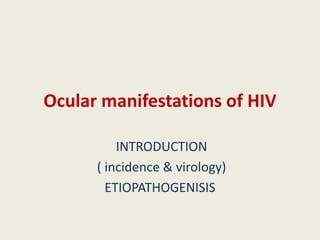
introduction to HIV
- 1. Ocular manifestations of HIV INTRODUCTION ( incidence & virology) ETIOPATHOGENISIS
- 2. History • 1st reported on June 5, 1981 when the U.S Centers for Disease Control recorded a cluster of Pneumocystis carinii pneumonia in five homosexual men in Los Angeles • Its cause HIV was identified in the early 1980s 2
- 3. • Human immunodeficiency virus (HIV) is a blood- borne, sexually transmissible virus.
- 4. Global prevalence • In 2014, WHO estimated 33.4 million people worldwide living with HIV/AIDS, • with 2.7 million new cases of HIV infection per year • and 2.0 million deaths due to AIDS 4
- 5. • According to UNAIDS report, 60 million people have been infected since the start of pandemic , with 25 million deaths, and 14 million orphaned children in southern Africa alone 5
- 7. NACO 2015
- 8. Classification of HIV • Two serological types • HIV – 1 (world wide) • HIV – 2 (West Africa & Portugal) • HIV – 1 • HIV – 2 1.Type M 1. Type A, B,C,D and E 2. Type O 8
- 9. • HIV is a member of the genus Lentivirus, part of the family Retroviridae . • it is composed of two copies of positive single- stranded RNA • the single-stranded RNA is tightly bound to nucleocapsid proteins, p7, and enzymes needed for the development of the virion such as reverse transcriptase, proteases, ribonuclease and integra se.
- 10. • the viral envelope contains proteins from the host cell and relatively few copies of the HIV Envelope protein, which consists of a cap made of three molecules known as glycoprotein (gp) 120,
- 11. Type 1… • HIV-1 probably originated from one or more cross-species transfers from chimpanzees in central Africa. • HIV-2 is closely related to viruses that infect sooty mangabeys in western Africa. • Genetically, HIV-1 and HIV-2 are superficially similar, but each contains unique genes and its own distinct replication process.
- 12. Type 2… • HIV-2 carries a slightly lower risk of transmission, and HIV-2 infection tends to progress more slowly to acquired immune deficiency syndrome (AIDS). • This may be due to a less-aggressive infection rather than a specific property of the virus itself. • Persons infected with HIV-2 tend to have a lower viral load than people with HIV-1, and a greater viral load is associated with more rapid progression to AIDS in HIV-1 infections • HIV-2 is rare in the developed world. Consequently, most of the research and vaccine and drug development has been (perhaps unfairly) focused on HIV-1
- 14. etiopathogenesis • Mode of infection
- 15. HIV Transmission Requires: 1. Infected body fluid AND 2. Entry into body
- 16. Mode of transmission • Sexual contact – 70% of cases • IV drug use – 27% • Blood transfusion – 2-3% • Perinatal transmission – 1% 16
- 17. 3. Infected body fluids Four Fluids, if infected, can transmit HIV a. Blood b. Semen c. Vaginal Secretions d. Breast Milk If these enter the body
- 18. 4. Which Fluids are safe? Four Fluids that can’t transmit HIV a. Spit/saliva b. Pee/Urine c. Sweat d. Tears
- 19. How Does HIV get into a T Cell? 1. attaches to infection fighting T4 cell 2. Locks on to two entry areas of the T4 cell at once. (Keys in lock) 3. Tricks T4 cell to allow Virus RNA to enter
- 20. What Does HIV do inside a T Cell? 1. Virus’s RNA changes into DNA 2. Enters Cell nucleus & becomes part of Host’s DNA! 3. Programs T cell to produce virus in abundance 4. New viruses bud off Host T cell, killing T cell, & enters bloodstream 5. New HIV viruses infect more T cells
- 21. Flowchart Binding to CD4 Internalization Uncoating Reverse transcriptase Integrated proviral DNA Productive infection Latent infection Mature HIV production Cell lysis 21
- 22. New HIV viruses leaving a cell
- 23. Pathophysiology • HIV attaches to T-cells & monocytes /macrophage that display a membrane Ag- complex known as CD4. • The target cells of HIV show different cytopathic effects • CD4 + helper T-cells – decrease in number – immunodef. – opportunistic infections 23
- 24. * Macrophage – > decreased migration response to chemoattractants > defective intracellular killing of mircroorg. (eg. Toxo. , Candida.) > impaired Ag presentation *excessive production of TNF-alpha –leads to dementia , wasting , unexplained fever.
- 25. 6. What is the “Window Period?” The time period between a person’s exposure & actual infection with HIV and until antibodies are detectable in the body. • After three months there are usually enough antibodies to show on an AIDS test. Nearly all people (99%) develop antibodies by THREE months.
- 26. • Th pressence of any two major signs associated with atleast one minor sign is considered to be an indiaction of AIDS
- 27. Major signs include • Loss of more than 10% of body weight • Chronic fever • Chronic diarrhoea of over 1 months duration
- 28. Minor signs include • Chronic cough • Itchy dermatitis • Recurrent herpese zoster • Oropharyngeal candidiasis • Chronic progressive herpes simplex infection • Generalised lymphadenopathy
- 29. • Eye involvement seen in 90% Autopsy cases • Ocular complication in 75% of pts with AIDS • Visual morbidity & blindness is the leading cause of suicide in pt. with AIDS • May be the first sign of HIV infection this shows the Role of Eye consultant to make a sight saving & life sustaining Diagnosis 29
- 30. To be continued…